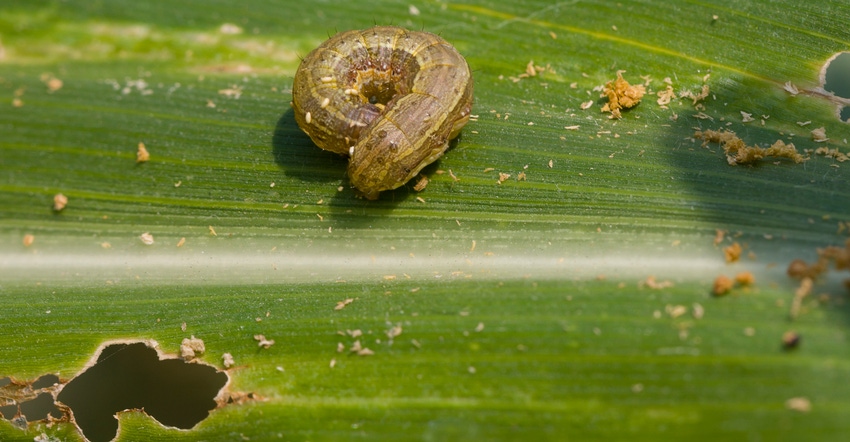May 8, 2017

By Christina DiFonzo
Over the last few weeks, weather patterns were ideal to carry insects from the south into Michigan. Armyworm and black cutworm catch has been impressive in Illinois. There are “intensive” black cutworm flights in some sites in the Purdue University trap network, and a big catch of armyworm at the Northeast Purdue Agricultural Center. Armyworm catch was high in some Michigan State University traps as well, although numbers dropped off this week.
The risk of both of these pests increases with weediness and wet fields. The good news is that weather patterns in the next few weeks are changing, and movement of moth from south to north will be much less. In the meantime, we have to deal with the moths that already made it into the state.
Egg-laying sites
Black cutworm lays eggs on grassy weeds or cover crops, low-growing winter annuals and no-till crop residue like dead stems or stalks. This spring is a banner year for winter annuals, particularly chickweed and purple dead nettle. To quote MSU Extension weed scientist Christy Sprague, it is “one of the worst springs ever.”
Moths will find plenty of egg-laying habitat. Small larvae feed aboveground on weeds or seedlings, making small pinholes that would be difficult to notice on a quick walk in the field. Older larvae feed below ground, cutting off plants at the base (before V6) or boring through the stalk at the soil line (after V6). Cut or damaged plants wilt and die.
Armyworms lay eggs in areas of dense vegetation, such as weedy fields, cover crops, grassy alfalfa stands and wheat fields. Cornfields, weedy fields, reduced and no-till fields, and corn planted after alfalfa are at higher risk, as are parts of fields along ditch banks, fencerows and small grain fields. Larvae climb plants and feed aboveground, giving corn leaves a tattered appearance. In severe infestations of corn, only the midrib is left. In wheat, larvae feed on the leaves and may clip heads. As small grains mature and dry down, larvae can “march” like an army en masse into neighboring cornfields. Larvae feed at night, but hide near the base of plants or down in corn whorls during the day. Besides damage, a give-away of armyworm during the day is to look for large cylindrical frass pellets in the whorl of corn or on the ground in a wheat field.
Damage to crop
For both insects, a heavy flight does not necessarily translate into an infestation in an individual field. Infestations can be patchy across a region, depending on where moths dropped out of a weather front and attractiveness of individual fields for egg laying, i.e., denser vegetation in wheat or weedy corn. Damage in corn depends largely on the timing and effectiveness of weed control. Plowing, or herbicide applications made early to kill weeds or terminate a cover crop, removes egg-laying sites.
This year is a challenge given the recent rains and the density of the weeds in many fields. Herbicide applications made at or just after planting remove the alternate food source, forcing larvae onto the crop. This is when damage occurs to the crop, and another reason it differs from field to field. This is also why weather plays an important role in the story. The combination of weather fronts that dumped a lot of moths into the state and wet conditions, which delay planting, crop emergence, cover crop termination or herbicide application, can synch the larval life cycle with crop emergence, potentially exposing crops to more larvae for a longer damage period.
Scouting
At this point, moths are in the midst of egg laying. Scouting for cutworm cutting in corn should start 300 degree days (DD) after a significant flight in an area, defined as more than nine moths captured in a bucket trap over a two-night period. After 300 DDs have passed, start walking fields to look for cut plants or gaps in rows. The threshold is 5% of plants cut.
For armyworm, there isn’t a trap catch scouting threshold per se, but trap numbers have been high. Start scouting fields in about three weeks, looking for leaf damage and frass or larvae in the whorl (larvae may be on the ground at base of plants). If there is limited time to scout corn in May and early June, concentrate on non-Bt cornfields, since most Bt hybrids contain at least one trait that controls armyworm and cutworm.
Also, on fields where annual weed pressure was heaviest, or where a cover crop was terminated late.
Note that even Bt corn can suffer damage by these insects under heavy pressure. This happens because small larvae start out on weeds and cover crops, and only move to Bt corn much later in life. Large larvae need to eat, and they tend to be less susceptible to Bt toxins. The threshold is 25% of plants with at least two larvae per whorl or 75% of plants with a single larva per whorl.
For armyworm on wheat, the story is different and not tied to weed control because egg laying occurs directly in small grains in spring. Thus, armyworm outbreaks in wheat tend to occur on a wider scale, with most or all fields in a neighborhood infested. High trap captures are an alert to scout for leaf feeding so that populations can be managed quickly across an area before head clipping occurs. Walk fields to look for flag leaf defoliation and cut heads, and larvae at the base of plants. The threshold is four or more larvae per square foot before heading, and two or more larvae per square foot at heading.
DiFonzo writes for Michigan State University Extension, Department of Entomology.
You May Also Like




